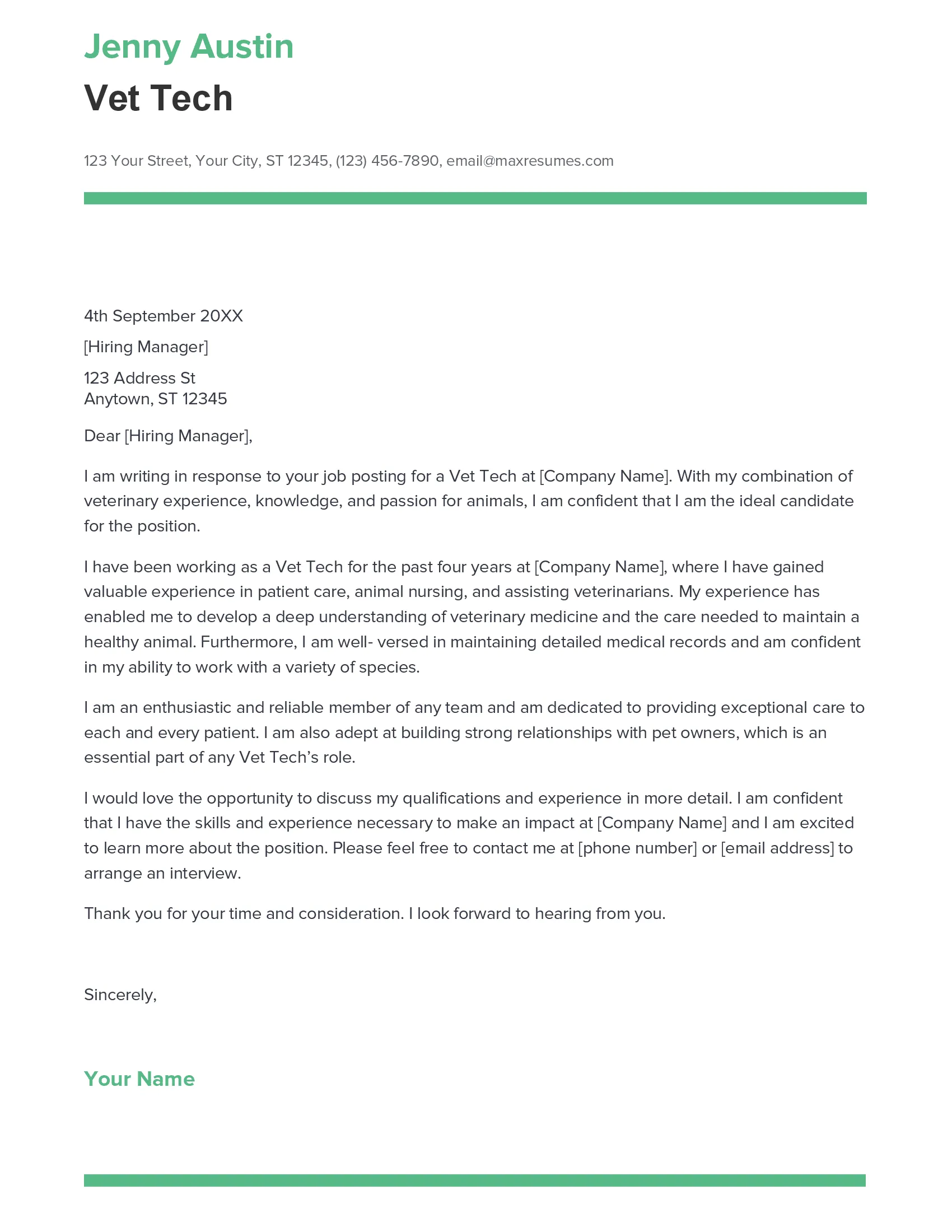Crafting Your Vet Tech Cover Letter
A well-crafted cover letter is your key to unlocking the door to your dream veterinary technician position. It’s more than just a formality; it’s your first impression, a chance to showcase your skills, passion, and suitability for the role. This guide will walk you through the essential steps to create a compelling cover letter that grabs the attention of hiring managers and sets you apart from the competition. From the initial greeting to the final sign-off, we’ll cover all the crucial elements, providing you with the tools and knowledge you need to make a lasting impact and secure an interview. Remember, your cover letter is a story, and you are the author.
Understanding the Purpose
The primary purpose of a cover letter is to introduce yourself and provide a snapshot of your qualifications to a potential employer. It’s an opportunity to go beyond the confines of your resume and share your story, highlighting why you’re the perfect fit for the veterinary technician position. Think of it as your personal marketing document, designed to persuade the hiring manager that you possess not only the necessary skills and experience but also the right attitude, enthusiasm, and personality to thrive in their clinic or hospital.
Why a Cover Letter Matters
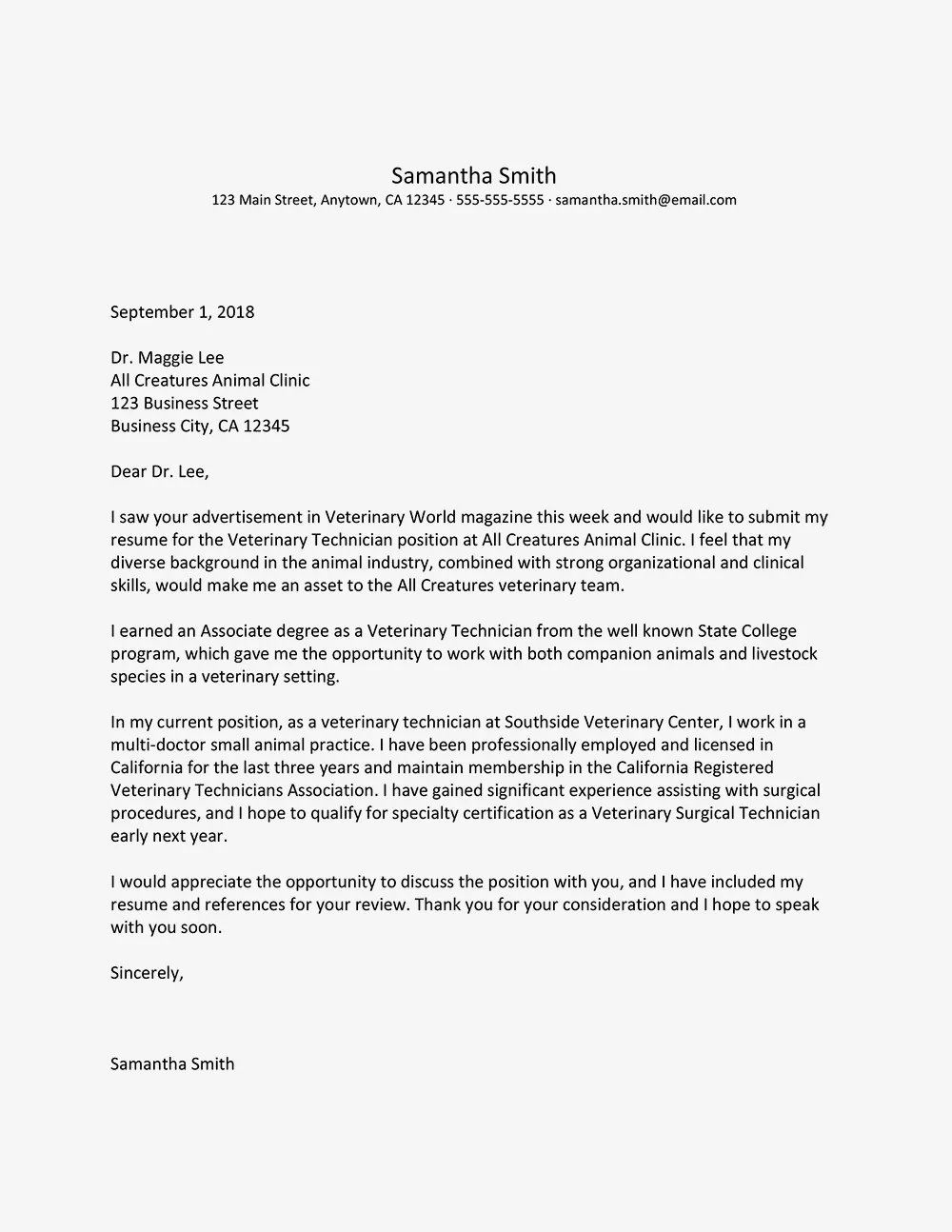
In a competitive job market, a cover letter can be your secret weapon. It allows you to connect with the hiring manager on a personal level, demonstrating your genuine interest in the role and the specific practice. It’s your chance to explain any gaps in your resume, highlight your unique skills, and tailor your application to the specific requirements of the job posting. A well-written cover letter shows that you’ve put in the extra effort, taking the time to research the practice and articulate why you’re a valuable asset, which can significantly increase your chances of getting an interview and ultimately, landing the job. Furthermore, it is proof that you have the ability to communicate effectively.
Key Components of a Vet Tech Cover Letter
A strong vet tech cover letter should include several key components, each serving a specific purpose in showcasing your qualifications and personality. These components work together to create a cohesive and persuasive narrative that grabs the reader’s attention. These include your contact information, a professional salutation, a compelling opening paragraph, a section highlighting your skills and experience, a demonstration of your passion for the field, a strong closing, and a final proofread for any errors. Each element is critical to demonstrating that you are the right candidate for the job.
Contact Information Section
Begin your cover letter with your contact information. This section should be clear, concise, and easy to read. It provides the hiring manager with the necessary details to reach you if they wish to proceed with your application. Accuracy is key; double-check that all your contact details are correct. Make sure the information is easy to find and clearly presented, allowing the recruiter to quickly understand how to contact you.
Formatting Your Contact Info
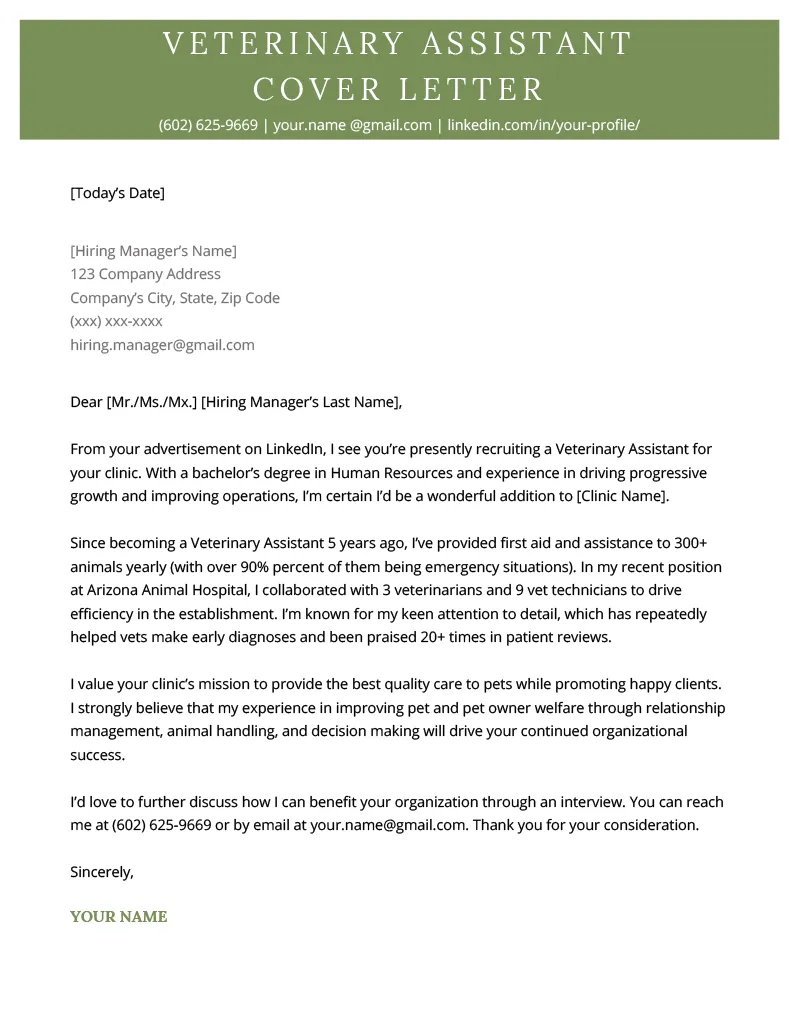
Format your contact information at the top of your cover letter, either left-aligned or centered. Include your full name, phone number, email address, and optionally, your LinkedIn profile URL. Ensure your email address is professional; avoid using nicknames or unprofessional handles. Choose a clear, easy-to-read font, and use a font size between 10 and 12 points. Using a consistent font throughout your cover letter ensures a polished and professional look, increasing your chances of a positive first impression.
The Salutation
The salutation is your first point of direct communication. It sets the tone for the rest of your cover letter. Using the right salutation shows that you know the recipient, and you took the time to get this right. Avoid using generic greetings. Address the hiring manager by name if possible.
Professional Salutations
Whenever possible, address the hiring manager by name, using ‘Dear Mr./Ms./Dr. [Last Name]’. This personalized approach shows that you’ve done your research and are genuinely interested in the position. If you’re unsure of the hiring manager’s name, a professional alternative is ‘Dear Hiring Manager’ or ‘Dear [Clinic Name] Team’. Avoid outdated or informal salutations like ‘To Whom It May Concern’ or ‘Dear Sir/Madam’, as these can give the impression that your application is generic. Personalizing this section demonstrates professionalism and attention to detail.
Writing the Opening Paragraph
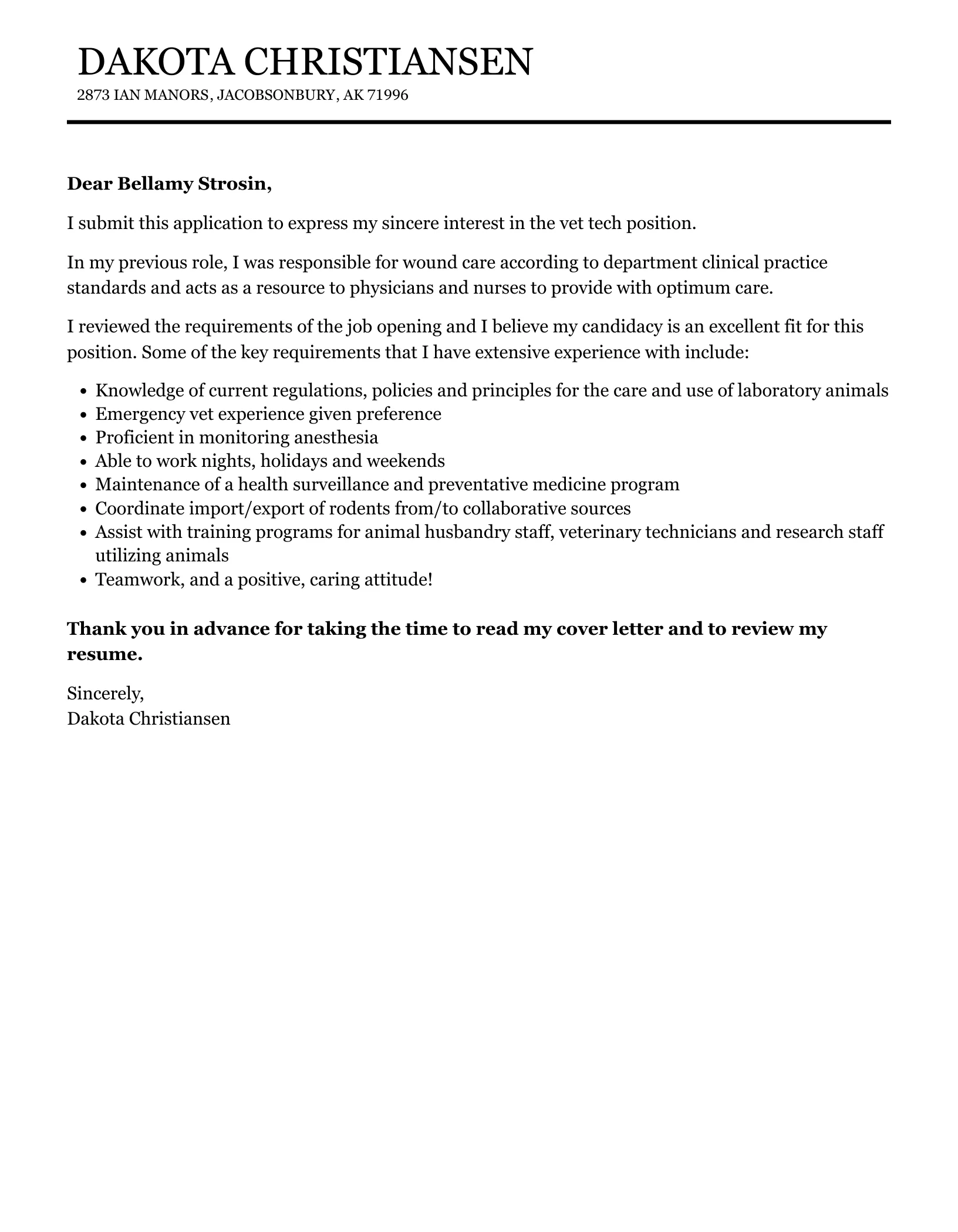
The opening paragraph is your first opportunity to grab the hiring manager’s attention. It should immediately state the position you’re applying for and how you found the job listing. Briefly mention your relevant skills and experience and express your enthusiasm for the opportunity. This section is where you want to make a strong first impression and convince the reader to continue reading. It also establishes your intent, letting the recruiter know you are a serious applicant.
Expressing Enthusiasm
Show genuine enthusiasm for the veterinary technician role and the specific practice. Highlight what specifically interests you about the position or the clinic’s values. This can be achieved by mentioning specific aspects of the job that appeal to you or by referencing the practice’s mission or reputation. Doing this shows you’ve researched the role and are genuinely interested in becoming part of their team. Letting the hiring manager see your enthusiasm is the first step to having them consider your application.
Highlighting Your Skills and Experience
The body of your cover letter is where you showcase your relevant skills and experience. Instead of simply listing your duties, provide specific examples that demonstrate your abilities. Tailor this section to the job description, emphasizing the skills and experiences that align with the employer’s needs. Use action verbs and quantify your achievements whenever possible to make your accomplishments more impactful. Your goal is to show the hiring manager that you not only possess the required skills but also have a proven track record of success in a veterinary setting.
Technical Skills to Include
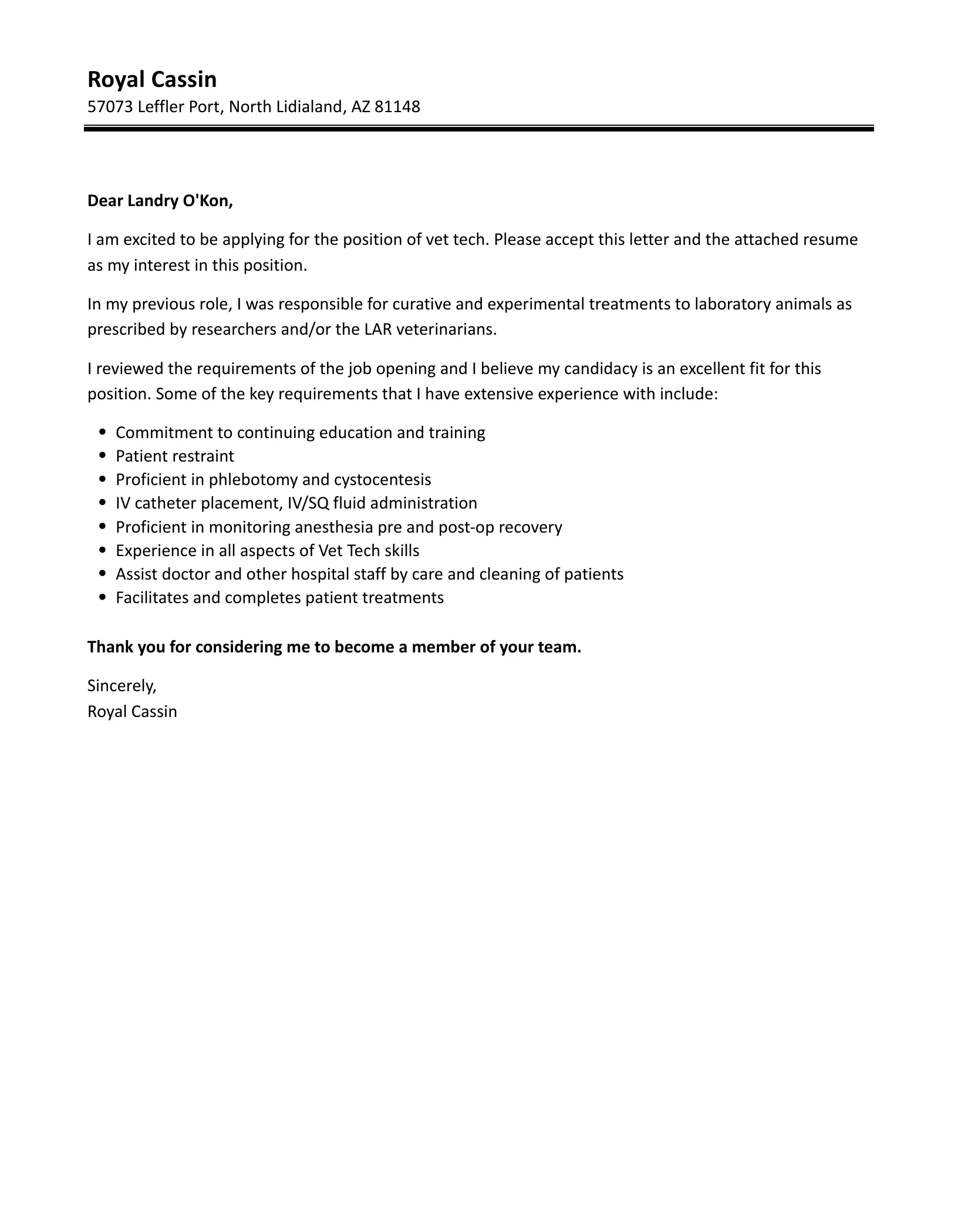
Highlight your technical skills relevant to the veterinary technician role, such as phlebotomy, anesthesia monitoring, radiology, surgical assisting, and laboratory procedures. Provide specific examples of how you’ve used these skills in previous roles. For example, instead of simply stating ‘performed blood draws,’ specify ‘successfully performed over 50 blood draws on various animal species with minimal patient discomfort.’ Including these details shows that you can complete the job well and handle a variety of scenarios.
Soft Skills to Emphasize
Don’t forget to include soft skills, such as communication, teamwork, problem-solving, and empathy. Provide examples of how you’ve demonstrated these skills in a professional setting. For instance, describe a situation where you effectively communicated with pet owners to explain a diagnosis or treatment plan, or how you collaborated with a veterinary team to resolve a difficult case. Highlighting your soft skills demonstrates your ability to provide high-quality care.
Quantifying Your Achievements
Whenever possible, quantify your achievements to make them more impactful. Use numbers to showcase your successes and demonstrate the value you bring to the table. For example, instead of saying ‘improved patient care,’ state ‘improved patient care by implementing a new protocol that reduced recovery time by 15%.’ Quantifying your achievements provides concrete evidence of your abilities and makes your cover letter more persuasive. Showing what you can do and how well you can do it shows your attention to detail.
Demonstrating Your Passion
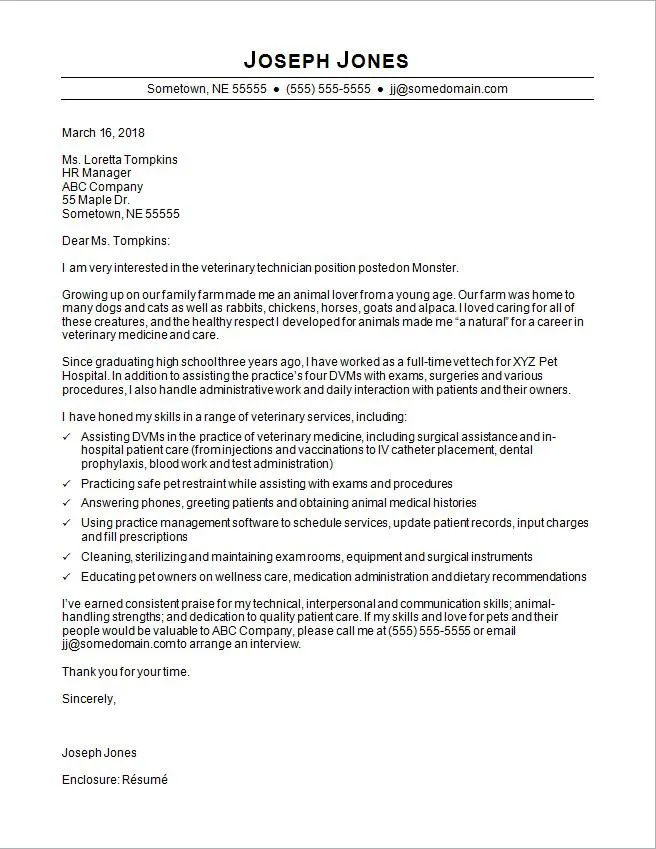
Veterinary medicine is a field driven by compassion and a love for animals. Your cover letter should reflect your genuine passion for the profession. Share why you chose this career path, what motivates you, and what you enjoy most about working with animals. This demonstrates that you are not just looking for a job but are committed to providing the best possible care for pets.
Showcasing Animal Care Experience
Detail your experience working with animals, including specific examples of patient care, handling, and treatment. If you have volunteered at an animal shelter or have previous experience with pets, include those details. Share any experience you have in assisting with surgeries, administering medications, or performing diagnostic tests. Mention any special skills you may have, such as experience with exotic animals or specific breeds. Detailing the specific species of animals you have experience with helps the reader understand your strengths.
Mentioning Specific Species
If you have experience working with specific animal species, make sure to mention them. This is particularly important if the practice specializes in a certain type of animal. For example, if you’re applying to a clinic that specializes in feline medicine, highlight your experience with cats. Similarly, mention experience with dogs, horses, birds, or any other species relevant to the job. Tailoring your experience to the clinic’s focus increases your chances of getting noticed and demonstrating you are a good fit.
Closing Your Cover Letter
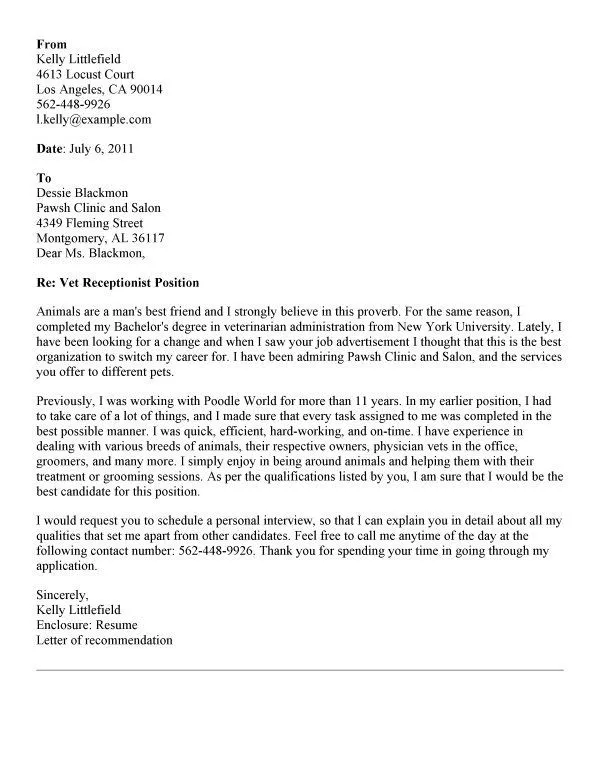
The closing of your cover letter is your final opportunity to leave a positive impression. It’s important to express your gratitude, reiterate your interest, and provide a clear call to action. A thoughtful and professional closing paragraph reinforces your qualifications, showing the hiring manager that you are the right person for the role. It should be clear that you are taking the application process seriously.
Expressing Gratitude
Thank the hiring manager for their time and consideration. Show your appreciation for the opportunity to apply for the position. This simple act of gratitude reinforces your professionalism and demonstrates that you value the chance to be considered for the role. It demonstrates that you are not only qualified but also thankful for the opportunity.
Call to Action
End your cover letter with a clear call to action. State your interest in an interview and mention your availability. Provide your contact information again, just in case the hiring manager needs to refer back to it. Make it easy for the employer to move forward with your application. This is your final push to secure an interview and get hired.
Proofreading and Editing
Proofreading and editing are essential steps in the cover letter writing process. Errors in grammar, spelling, and punctuation can undermine your credibility and leave a negative impression. Take the time to carefully review your cover letter for any mistakes. Read it aloud to catch any awkward phrasing or unclear sentences. Consider having a friend or family member review your cover letter for an outside perspective. A polished cover letter demonstrates that you pay attention to detail and are committed to presenting yourself in the best possible light.
Common Mistakes to Avoid
Avoid common mistakes that can negatively impact your application. Ensure that the cover letter is tailored to the specific job and practice, not a generic template. Don’t make errors in grammar, spelling, or punctuation. Avoid exaggerating your skills or experience. Don’t use jargon or technical terms that the hiring manager may not understand. Don’t use a generic greeting or closing. By avoiding these pitfalls, you’ll significantly improve the quality and impact of your cover letter.
